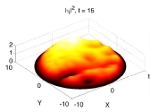Bose-Einstein condensation occurs for bosons when, for a temperature low enough (typically a few nanokelvins for a gaseous condensate), a macroscopic fraction of the bosons gathers in the quantum state of lowest energy, forming a Bose-Einstein condensate (BEC). In this case, the behavior of the fluid can be described in the case of a dilute gas by the nonlinear Schrödinger equation (NLS), also called the Gross-Pitaevskii equation. It can be shown that the dynamics of the NLS is very close to shallow water dynamics with surface tension. One of the striking features of BECs is the possibility of point vortices to appear, which dynamics is explained in some the oldest textbooks of fluid dynamics. Surprinsingly, although vortices in BECs have been extensively studied, some of the most simple Gendankenexperiments have yet to be studied. For example, the (apparently) simple problem of the motion of a single vortex along a plane boundary in a semi-infinite, uniform BEC has been solved in 2006 only, eighty-two years after Einstein’s translation of the letter Bose wrote him about what would later be called Bose-Einstein statistics. An opportunity is then to be seized by classical fluid dynamicists, who can make the study of quantum fluid dynamics benefit from their experience. The idea of the present project, unlike those who use an almost all-analytical approach, is to develop a numerical code to integrate the NLS in polar coordinates and to perform a few numerical experiments about vortices in a two-dimensional circular box (a “glass”). In this report, we will first present some aspects of quantum fluid dynamics for geophysical fluid dynamicists to understand the analogies between the two fields. The code written during the project will then be presented next. A few numerical experiments will then be presented to validate the code, study various simple configurations and see what the code can do. Finally, conclusions are drawn as well as possible extensions of this work.




